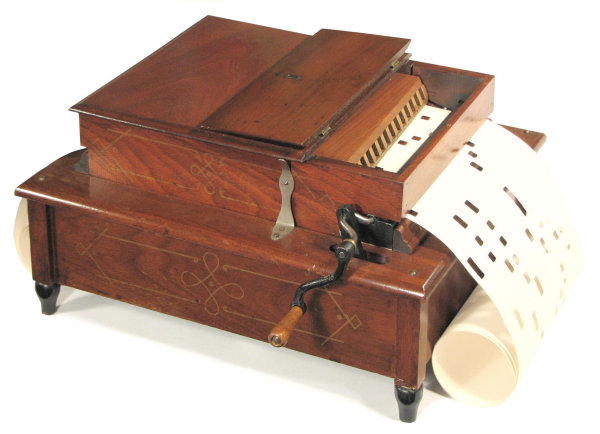 The "American Orguinette"
The "American Orguinette"
A "Mechanical Organette" (or "orguinette") is a small table-top reed organ which plays pre-recorded music. The music is stored as a pattern of holes in a sheet or disc of paper or cardboard, or as a pattern of pins set into a wooden cylinder. The sound is produced from vibrating reeds, usually of brass or steel, which are activated by air pressure or suction from a hand-cranked bellows system.
Mechanical organettes have an important place in history as the first affordable instruments for the mass distribution of recorded music. They were made in enormous quantities and in a great variety of styles, beginning in the late 1870s and continuing until superseded by the gramophone in the early 1900s.
Although the instruments shown on this page play only 14 notes, their musical arrangements were often surprisingly effective. Here are a couple of typical examples, each scanned and re-mastered from original 14-note tune sheets from the early 1880's:
There are more downloadable MIDI files on the 14-note Organette Music page. The "American Orguinette"
The "American Orguinette"
The illustration shows a typical 14-note "American Orguinette". These and similar instruments were produced in great quantity by the Munroe Organ Reed Company of Worcester, Massachusetts, and were re-sold around the world under a variety of brand names.
The instrument measures 15" wide x 12" deep x 8" high, and weighs 7 pounds. The lower section of the case contains the suction bellows, reservoir, and cranking mechanism. The upper section is held in place by two large spring clips on the sides, so that it can be removed to fit the paper roll or "tune sheet". The tune sheet is drawn through the instrument by rubber rollers on the crankshaft. The reeds are located in the slotted wooden block which is visible in the front of the upper section. The holes in the paper tune sheet acts as valves, allowing air to be drawn through the corresponding reeds to sound the notes. The hinged cover can be opened or closed to vary the volume.
Instruments such as this sold for around $5.00 in the early 1880s, equivalent to almost a week's wages for the average worker, or well over five hundred dollars in today's money.
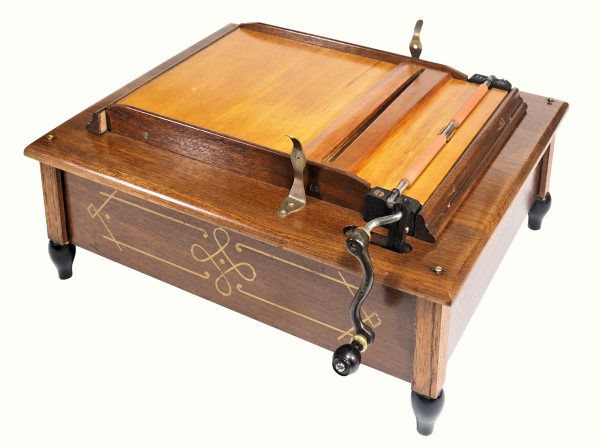 The soundboard and windchest
The soundboard and windchest
This view with the upper section removed shows the soundboard and windchest, surrounded by wooden trim strips which guide the tune sheet through the machine. The soundboard acts as an amplifier to distribute the sound from the reeds.
The tapered slot near the centre of the soundboard opens into the windchest, which is under constant suction. Air will be drawn down through the slot, and through the corresponding reed above, whenever a path is opened by a hole in the tune sheet.
The first European reed organs (or "harmoniums") from the 1840s operated on pressurised air, in the same manner that pipe organs had done for centuries. The American reed organ builders soon realised that suction bellows are much easier to make, and their instruments have mostly operated on suction ever since. The reeds are happy either way.
The crankshaft to the right of the machine carries two sections of replaceable rubber tubing which act as feed rollers for the tune sheet. A spring-loaded pressure roller in the upper section of the case keeps the sheet in firm contact with the feed rollers.
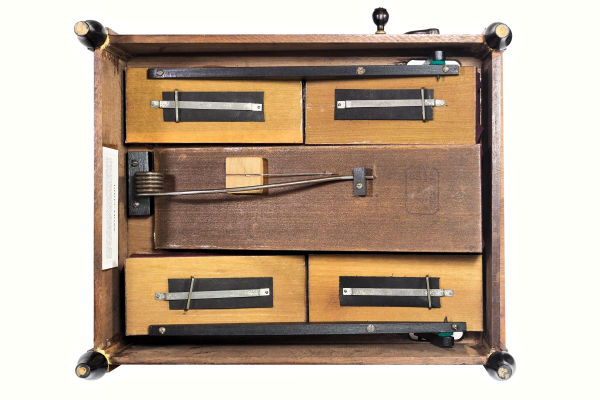 The air supply
The air supply
On the underside of the lower section are four small pumping bellows (properly called "exhausters") which create the suction in the wind chest above. Between the exhausters is the spring-loaded reservoir or "equaliser", which provides a reserve of suction and helps to smooth out pressure variations. Reed organs operate on very low pressure differences, typically only about 3 to 5 inches of water, or 1/8 of a pound per square inch. The reservoir has a small spring-loaded relief valve to prevent damage from over-pressure.
The black leather flaps on the underside of the four exhausters are one-way valves to control the air flow. There is a second set of internal flap valves between the exhausters and the windchest. The inside valves are inaccessible once the instrument is assembled.
The reservoir of this instrument is stamped with two illegible patent dates and the serial number 123010. The arrangement of the bellows is the same as that shown in US Patent 233147, filed by Isiah M Furbish in May of 1880.
The paper label to the left of the reservoir gives instructions for operation and maintenance of the instrument, including replacement of the rubber feed rollers.
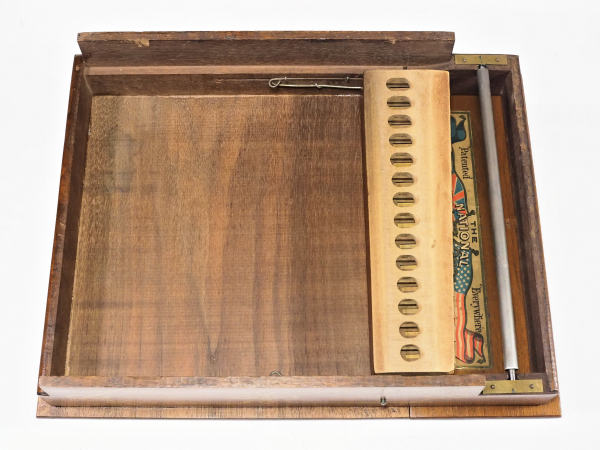 The upper section
The upper section
This view shows the underside of the upper section of the instrument. The reed block is mounted so that the reeds sit directly above the slot in the soundboard. The block is free to move vertically, and is held in contact with the tune sheet by two wire springs. It can be removed easily by withdrawing two retainer wires.
On the far right is the spring-loaded pressure roller which sits above the feed rollers on the crankshaft.
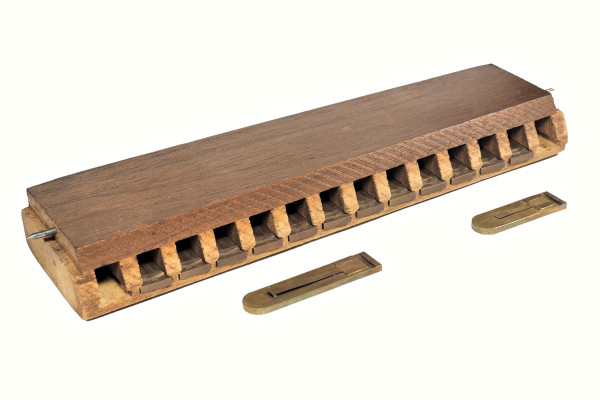 The reed block and reeds
The reed block and reeds
The 14 brass reeds are mounted in individual chambers or cells cut into a wooden block the same width as the tune sheet (7-3/4"). The highest and lowest reeds are shown removed from their cells. The block is aligned and held downwards by the metal pins at each end.
The American Organette uses a standard 14-note scale covering
almost 2 octaves (from A to F#, MIDI notes 57 to 78), but with
only one sharp.
The actual notes are :
A B C# D E F# G G#
A B C# D E F#
or, when transposed up 3 semitones:
C D E F G A Bb B
C D E F G A .
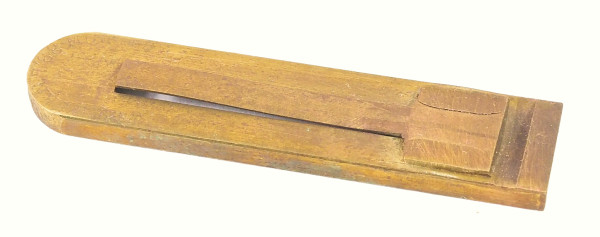 The reeds
The reeds
The organettes built by the Munroe Organ Reed Company use individual brass reeds of the same style that was supplied by the Company to various reed organ manufacturers from the 1860s onwards. They consist of a brass frame a little less than half an inch wide and one-tenth of an inch thick, to which is rivetted a vibrating brass reed or tongue. The dimensions of the tongue and the overall length of the frame are determined by the pitch of the note required. The shape of the curve in the tongue controls the "voicing" of the reed, or the nature of the sound produced. Two patent dates are stamped on the curved end of the frame: January 7th 1868 and March 14th 1882.
 "American Orguinette" case decoration
"American Orguinette" case decoration
The organette was an expensive instrument in its day, and was often decorated with elegant gold linework in a variety of geometrical patterns. The illustration shows the linework on the lower sides of the "American Orguinette" case.
 "National Mechanical Orguinette" label
"National Mechanical Orguinette" label
This illustration shows a typical distributor's label from inside the hinged lid of a 14-note organette. Although built in America, this instrument was sold by The National Fine Art Association in London before eventually finding its way to Australia.
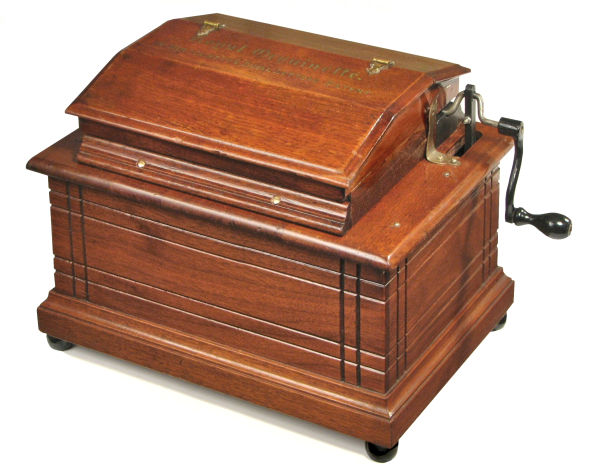 The 14-note "Royal Orguinette"
The 14-note "Royal Orguinette"
The "Royal Orguinette" is a variation on the more common "American" organette above.
This instrument measures 9" wide x 12" deep x 9" high, and weighs 7-1/2 pounds. It comes from the same factory as the model above, uses many of the same components, and plays the same tune sheets, but has a very clever and compact arrangement of the bellows and reservoir. It is built in a style called the "musical casket", with a decorative pattern cut into the sides of the mahogany-finished case.
The top cover is labelled "Royal Orguinette - by Her Majesty's Royal Letters Patent". The British patent number is unknown, but the same instrument is described in detail in US Patent 266914, issued to the Munroe Organ Reed Company in 1882.
 The "Royal Orguinette" soundboard
The "Royal Orguinette" soundboard
The Royal Orguinette also has a different arrangement of the windchest and soundboard. The reed block is attached permanently to the soundboard, with the tune sheet passing over the top instead of between the two. The upper section of the case contains another pressure roller to keep the tune sheet in contact with the top of the reed block. Access to the reeds can be had by releasing the black catch to the right of the block and removing the gasketted wooden cover strip.
The direct contact between the reed block and the soundboard gives this instrument a better and stronger tone than the version above, in spite of its smaller dimensions.
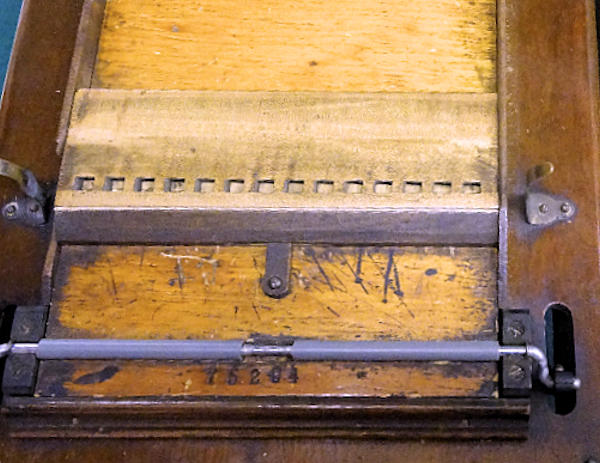 A later "American Orguinette"
A later "American Orguinette"
Attaching the reed block directly to the soundboard made such a significant improvement that later versions of the "American Orguinette" were fitted with the same arrangement. This photo (courtesy of John Farmer, UK) shows one such instrument prior to restoration.
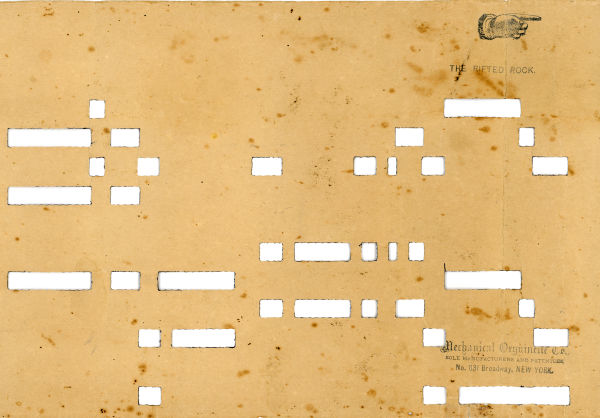 A 14-note tune sheet.
A 14-note tune sheet.
The idea of storing information as holes in strips of paper has been around for a very long time. Paper tapes and cards have been used as digital storage media in weaving looms in the 1700s, in telegraph machines in the 1800s, in tabulator cards around 1900, and in digital computers in the 1950s and 60s. The organette uses exactly the same principles, except that the information is processed pneumatically rather than mechanically or electrically.
This illustration shows the beginning of an original 14-note tune sheet from around 1880. The sheet is 7-3/4 inches wide, and is made from heavy paper (or thin cardboard) about 0.008" thick. The note slots are 9/32" wide on 17/32" centres, with a margin of 9/32" at each side. The sheets were produced on automatic perforators which advanced the paper in fixed steps of 1/8". The punches were made slightly longer (9/32" by 5/32"), so that punching on consecutive steps would cut continuous slots for the longer notes. The music arrangers generally used from 4 to 8 punch steps per quarter note, depending on the tempo and timing requirements for the particular tune.
A typical tune sheet is about 6 feet long and plays for about one minute. This hymn tune was joined head-to-tail to form a continuous loop, so that several verses could be sung without a break.
There were several major manufacturers of tune sheets, and a thriving industry in "pirate" copies of dubious quality. Note the pencil marks around the edges of the slots, where a previous owner has traced the hole pattern in order to cut a duplicate sheet.
 The Mechanical Orguinette Company.
The Mechanical Orguinette Company.
This detail of the tune sheet above carries the stamp of The Mechanical Orguinette Company of 831 Broadway, New York. This company was formed in 1878 to sell organettes manufactured by the Munroe Organ Reed Company. The Broadway address was in use from 1880. The Mechanical Orguinette Company was so successful that it purchased the entire Munroe operation in 1891, and re-named itself as The Aeolian Organ and Music Company. Aeolian later developed the Orchestrelle self-playing reed organ and the Pianola piano-playing mechanism, and went on to become one of the world's largest music companies. Like many others, it collapsed during the 1930s depression and never fully recovered.